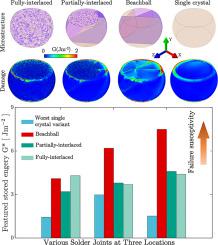当前位置:
X-MOL 学术
›
J. Mech. Phys. Solids
›
论文详情
Our official English website, www.x-mol.net, welcomes your feedback! (Note: you will need to create a separate account there.)
Mechanistic understanding of microstructural effects on the thermal fatigue resistance of solder joints
Journal of the Mechanics and Physics of Solids ( IF 5.3 ) Pub Date : 2024-03-27 , DOI: 10.1016/j.jmps.2024.105623 Yilun Xu , Jingwei Xian , Richard J. Coyle , Christopher M. Gourlay , Fionn P.E. Dunne
Journal of the Mechanics and Physics of Solids ( IF 5.3 ) Pub Date : 2024-03-27 , DOI: 10.1016/j.jmps.2024.105623 Yilun Xu , Jingwei Xian , Richard J. Coyle , Christopher M. Gourlay , Fionn P.E. Dunne

|
This paper uses a multi-scale crystal plasticity modelling approach to investigate the role of microstructure in the damage of Sn-3Ag-0.5Cu (wt%, SAC305) solder joints subject to thermal cycling. Faithful microstructure modelling has been developed to explicitly represent the complex microstructure characterized in the experiments. The mechanisms for the experimental finding that single crystal joints systematically outperform interlaced and beachball joints, in terms of damage development during thermal cycling, are found to be the localization of stored energy due to the grain boundaries. Interlaced regions, however, benefit the lifetime of solder joints versus a beachball microstructure by virtue of energy diffusion. The modelling results, together with experimental characterization, provide practical suggestions on how the microstructure could be designed to optimize the in-service lifetime of solder joints subject to thermal fatigue.
中文翻译:

微观结构对焊点抗热疲劳性能影响的机理理解
本文采用多尺度晶体塑性建模方法来研究微观结构在 Sn-3Ag-0.5Cu (wt%, SAC305) 焊点热循环损伤中的作用。已经开发出忠实的微观结构模型,以明确地表示实验中表征的复杂微观结构。实验结果表明,就热循环过程中的损伤发展而言,单晶接头系统地优于交错接头和沙滩球接头,其机制是由于晶界而导致存储能量的局部化。然而,与沙滩球微结构相比,交错区域通过能量扩散有利于焊点的使用寿命。建模结果与实验表征一起,为如何设计微观结构以优化热疲劳焊点的使用寿命提供了实用建议。
更新日期:2024-03-27
中文翻译:

微观结构对焊点抗热疲劳性能影响的机理理解
本文采用多尺度晶体塑性建模方法来研究微观结构在 Sn-3Ag-0.5Cu (wt%, SAC305) 焊点热循环损伤中的作用。已经开发出忠实的微观结构模型,以明确地表示实验中表征的复杂微观结构。实验结果表明,就热循环过程中的损伤发展而言,单晶接头系统地优于交错接头和沙滩球接头,其机制是由于晶界而导致存储能量的局部化。然而,与沙滩球微结构相比,交错区域通过能量扩散有利于焊点的使用寿命。建模结果与实验表征一起,为如何设计微观结构以优化热疲劳焊点的使用寿命提供了实用建议。



























 京公网安备 11010802027423号
京公网安备 11010802027423号